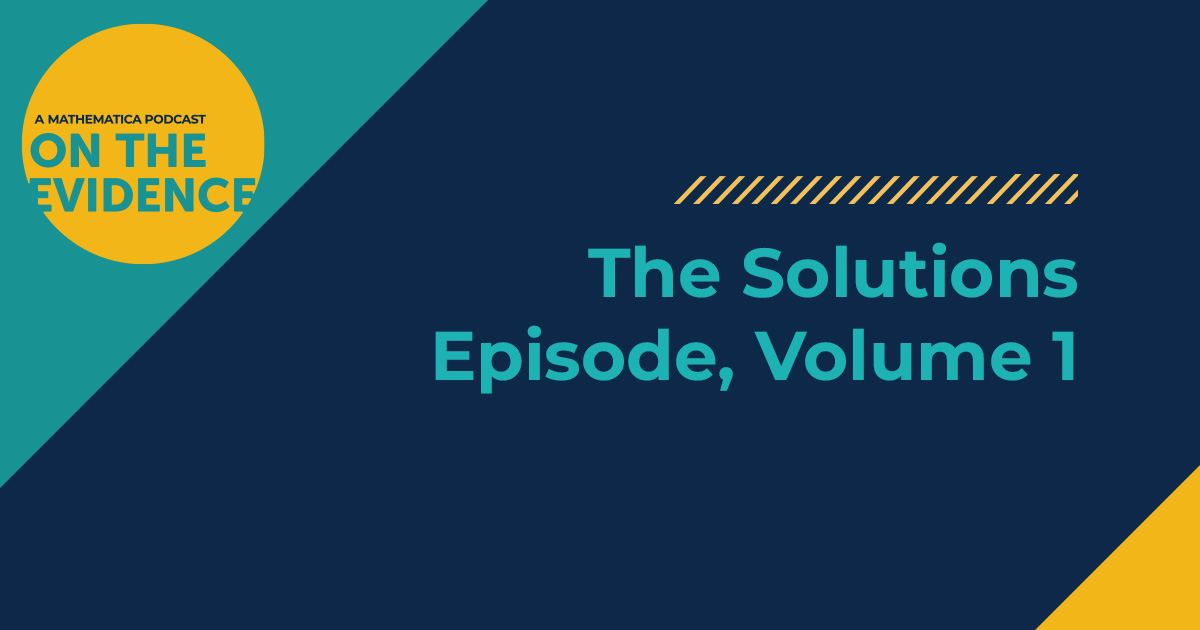Every year, Mathematica publishes dozens of new papers and reports, some of which surface fresh insights about how public agencies and private organizations can be more effective at improving public well-being. For the 91st episode of Mathematica’s On the Evidence podcast, we’re launching an occasional series focused on examples of solutions that recent research suggests are effective.
The series will cover a range of solutions that seek to address an urgent societal challenge and, importantly, are making a positive difference in people’s lives, according to recent Mathematica research. These episodes will call attention to caveats about the evidence and limitations to the solutions. We will also link to the full reports in the following show notes so listeners can dig deeper into the research details.
All three solutions in this episode involve financial incentives that seek to reduce health care costs while improving the quality of care patients receive. One seeks to reduce the incidence of heart attacks, strokes, or other events related to cardiovascular disease. Another is focused on bringing down the cost of health care and improving patient health by providing primary care services at home. And the last one, again, seeks to keep costs down while improving patient health, but this time by using a unique payment model that provides incentives to hospitals to change the way they do business.
Listen now.
View transcript
I’m J.B. Wogan from Mathematica and welcome back to On the Evidence.
This episode is the first in what we hope will become an occasional series on solutions.
Every year at Mathematica, we publish dozens of new papers and reports, and sometimes that research surfaces new insights about how public agencies and private organizations can be more effective at improving public well-being. Evidence on solutions has always been a part of the podcast, but we typically pick a small set of new research findings on a single topic and explore an issue in-depth with expert guests.
What we want to try here is to periodically produce shorter episodes that are jam-packed with examples of solutions that recent research suggest are effective.
Those solutions could be a wide range of things—new laws, new initiatives, new regulations, a change in organizational practices¬—that recent Mathematica research suggests are making a positive difference, in some way. We’ll do our best to flag any reasons to be cautious about declaring victory too soon and we’ll also link to the full reports in the show notes so that motivated listeners can dig more deeply into the details of the research.
By coincidence, all three solutions in this episode involve financial incentives that seek to reduce health care costs while improving the quality of care that patients receive. One seeks to reduce the incidence of heart attacks, strokes, or other events related to cardiovascular disease. Another solution is focused on bringing down the cost of health care and improving patient health by providing primary care services at home. And the last one, again, seeks to keep costs down while improving patient health, but this time by using a unique payment model that provides incentives to hospitals to change the way they do business.
If you’re not a health policy wonk: Don’t worry, future episodes will also touch on other public policy topics and levers being tested to address urgent issues.
Our first example comes from the Million Hearts initiative, which is led by the Centers for Disease Control and Prevention and the Centers for Medicare & Medicaid Services, otherwise known as CMS. The initiative aims to prevent one million heart attacks and strokes over five years.
And as some listeners may already know, cardiovascular disease remains the leading cause of death in the United States, so it was encouraging to see the figure 3.8 percent in big, bold font in a recent Mathematica release.
That figure represents the decrease in cardiovascular disease risk scores among Medicare beneficiaries who were previously at high risk of having a heart attack or stroke in the next 10 years. The finding comes from the fourth year in an ongoing evaluation of the Million Hearts Cardiovascular Disease Risk Reduction Model from CMS, Mathematica, and the RAND Corporation.
The model, which ran from 2017 through 2021, paid participating health care providers for two things: First, they paid providers for measuring each of their Medicare patients’ risk of a heart attack or stroke over the next 10 years and second, for reducing that risk among high-risk patients. By high risk, just for clarity’s sake, we’re talking about patients whose risk of a heart attack or stroke in the next 10 years was 30 percent or higher.
While financial incentives certainly mattered in the model, Mathematica researchers say the incentives aren’t the only reason for the improvements. Another important factor is that the organizations, which volunteered to participate, all committed to assess cardiovascular risk for their Medicare patients and to follow-up with high-risk patients. Some combination of payments and commitments likely drove the model effects.
This was a national five-year randomized trial involving 345 primary care practices, specialty practices, health centers, and hospital outpatient departments. In the first two years of the model, health care organizations in the study enrolled about 392,000 Medicare beneficiaries.
The decrease in risk scores among high-risk beneficiaries was driven by decreases in beneficiaries’ systolic blood pressure and low-density lipoprotein cholesterol. The study also found that the model resulted in better preventative care practices. For example, medium and high-risk beneficiaries were more likely to start using statins and anti-hypertensive medications, which are recommended in clinical guidelines for preventing cardiovascular disease.
While it’s encouraging that the model reduced the risk of cardiovascular disease events among Medicare beneficiaries, it’s not clear yet whether the lower predicted risk translated to actual lower rates of heart attacks and strokes. Results from the fifth and final year of the evaluation, which are expected in the summer of 2023, may shed light on the model’s impacts on reducing those cardiovascular disease events.
Our second solution comes from Maryland, which has pioneered a health care payment model that the state and CMS hope will reduce health spending while improving patients’ health. Things seem to be heading in the right direction. Over three years, Maryland’s Total Cost of Care Model saved Medicare more than $780 million, according to a recent Mathematica evaluation for CMS. The evaluation also found that the model reduced preventable hospital admissions and decreased emergency department visits.
Interestingly, one of the encouraging parts of the study was a no-impact finding: Mathematica researchers found that the model had no measurable effects on patients’ ratings of their personal doctor or the hospitals in which they received care, suggesting that hospitals’ efforts to improve efficiency have not come at the expense of lower patient ratings.
In 2018, Maryland became the first state in the U.S. to implement a Total Cost of Care Model, which combines the use of global budgets with incentives to reduce the cost of care provided to Medicare beneficiaries from all providers, not just care from hospitals. By the way, that term, global budgets, means Maryland fixes the amount of revenue a hospital will receive in an upcoming year. The findings could be informative for similar efforts outside of Maryland. For example, two states, Pennsylvania and Vermont, are now experimenting with variations of global budgets to control their health care costs.
Future reports from Mathematica will evaluate the Maryland model’s impacts beyond the first three years.
Our last solution comes from a national demonstration that seeks to reduce Medicare spending and improve the quality of care that Medicare beneficiaries receive by offering payment incentives to home-based primary care practices. Congress enacted the Independence-at-Home demonstration when it passed the Affordable Care Act in 2010. Two years later, CMS launched the demonstration, which involves primary care clinicians providing services in the home rather than in an office, to chronically ill and functionally limited Medicare beneficiaries.
The theory behind the demonstration is that home-based primary care practices would provide timely, coordinated care to patients as they need it, especially after an emergency room visit or a hospital discharge. By getting that timely and coordinated care, patients would be healthier because clinicians would have prevented any worsening of chronic conditions and would have treated acute conditions promptly, decreasing the need for costly emergency room visits and hospital admissions.
After six years of finding relatively limited impacts, the most recent annual report from Mathematica’s ongoing evaluation estimated that the demonstration reduced total Medicare spending in 2020 by 10.7 percent, which translates to a reduction of about $459 per beneficiary each month. The report also noted some evidence that the demonstration reduced the probability of dying of any cause, which may partially explain the drop in spending, since health care spending tends to be higher in the months leading up to death. Mathematica also found some weak evidence that the demonstration reduced potentially avoidable hospital admissions and hospital admissions after an emergency room visit.
In 2020, the demonstration included 10 practices in eight states serving about 5,000 eligible beneficiaries. While the findings might point to the value of payment incentives for home-based primary care practices that meet spending and quality of care targets, the report’s authors cautioned against extrapolating too much from the one-year results, noting that the large reduction in 2020 could not be generalized to other years or to providers outside the 10 practices that participated in the demonstration during that year.
Congress has extended the demonstration through 2023, so future reports from Mathematica will cover the demonstration’s impacts in its eighth, ninth, and tenth years. It will be interesting to see if the large reduction in health spending in 2020 was an aberration or the beginning of a trend.
That’s it for our first Solutions Episode. I’m interested to hear what you thought of this new approach to covering evidence about what works to address some of the most urgent challenges of the day. I’ll leave an email address in the episode show notes where you can send us feedback.
As always, I want to thank you for listening to On the Evidence, the Mathematica podcast. This episode was produced by the inimitable Rick Stoddard. To catch future episodes of the podcast, look for us on YouTube, Spotify, Apple Podcasts, or visit us at www.Mathematica.org/ontheevidence.
Show notes
Email jwogan@mathematica-mpr.com to provide feedback about our approach to covering solutions on the podcast.
Read the fourth annual report from Mathematica for the Centers for Medicare & Medicaid Services on the evaluation of the Million Hearts Cardiovascular Disease Risk Reduction Model.
Learn more about the ongoing evaluation of the Million Hearts Cardiovascular Disease Risk Reduction Model.
Read the seventh annual report from Mathematica for Center for Medicare & Medicaid Innovation on the evaluation of the Independence at Home Demonstration.
Learn more about the ongoing evaluation of the Independence at Home Demonstration.
Read the report from Mathematica for the Center for Medicare & Medicaid Innovation on impacts from the first three years of the Maryland Total Cost of Care Model.
Learn more about Mathematica’s ongoing evaluation of the Maryland Total Cost of Care Model for the Center for Medicare & Medicaid Innovation.



